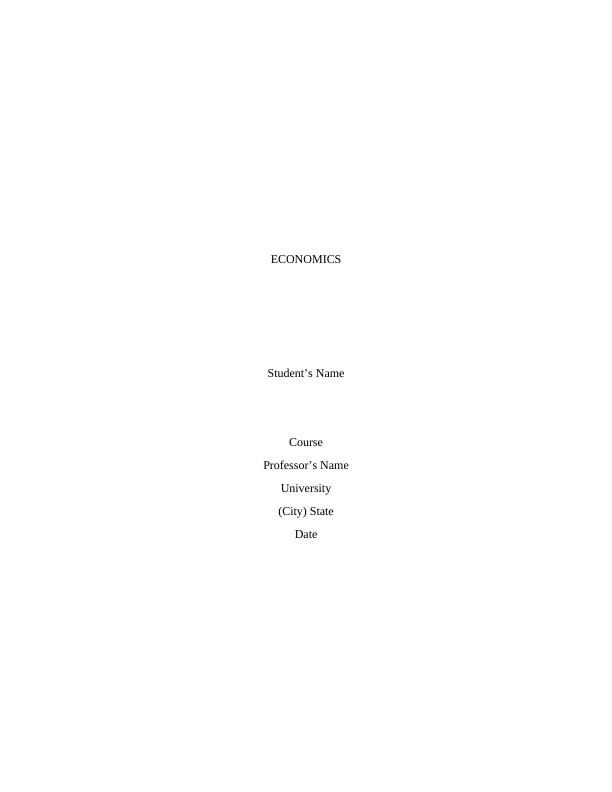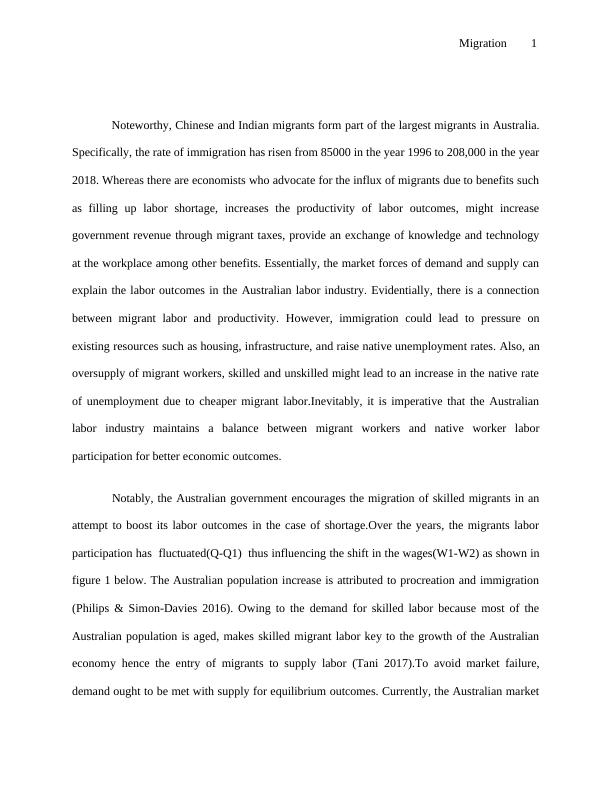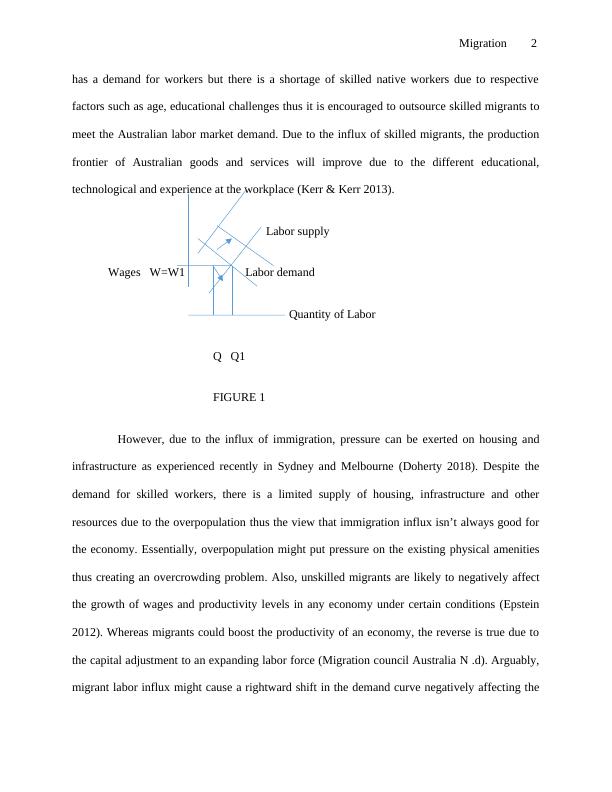Migration and its Impact on the Australian Labor Market
Added on 2023-04-07
7 Pages1074 Words325 Views
ECONOMICS
Student’s Name
Course
Professor’s Name
University
(City) State
Date
Student’s Name
Course
Professor’s Name
University
(City) State
Date

Migration 1
Noteworthy, Chinese and Indian migrants form part of the largest migrants in Australia.
Specifically, the rate of immigration has risen from 85000 in the year 1996 to 208,000 in the year
2018. Whereas there are economists who advocate for the influx of migrants due to benefits such
as filling up labor shortage, increases the productivity of labor outcomes, might increase
government revenue through migrant taxes, provide an exchange of knowledge and technology
at the workplace among other benefits. Essentially, the market forces of demand and supply can
explain the labor outcomes in the Australian labor industry. Evidentially, there is a connection
between migrant labor and productivity. However, immigration could lead to pressure on
existing resources such as housing, infrastructure, and raise native unemployment rates. Also, an
oversupply of migrant workers, skilled and unskilled might lead to an increase in the native rate
of unemployment due to cheaper migrant labor.Inevitably, it is imperative that the Australian
labor industry maintains a balance between migrant workers and native worker labor
participation for better economic outcomes.
Notably, the Australian government encourages the migration of skilled migrants in an
attempt to boost its labor outcomes in the case of shortage.Over the years, the migrants labor
participation has fluctuated(Q-Q1) thus influencing the shift in the wages(W1-W2) as shown in
figure 1 below. The Australian population increase is attributed to procreation and immigration
(Philips & Simon-Davies 2016). Owing to the demand for skilled labor because most of the
Australian population is aged, makes skilled migrant labor key to the growth of the Australian
economy hence the entry of migrants to supply labor (Tani 2017).To avoid market failure,
demand ought to be met with supply for equilibrium outcomes. Currently, the Australian market
Noteworthy, Chinese and Indian migrants form part of the largest migrants in Australia.
Specifically, the rate of immigration has risen from 85000 in the year 1996 to 208,000 in the year
2018. Whereas there are economists who advocate for the influx of migrants due to benefits such
as filling up labor shortage, increases the productivity of labor outcomes, might increase
government revenue through migrant taxes, provide an exchange of knowledge and technology
at the workplace among other benefits. Essentially, the market forces of demand and supply can
explain the labor outcomes in the Australian labor industry. Evidentially, there is a connection
between migrant labor and productivity. However, immigration could lead to pressure on
existing resources such as housing, infrastructure, and raise native unemployment rates. Also, an
oversupply of migrant workers, skilled and unskilled might lead to an increase in the native rate
of unemployment due to cheaper migrant labor.Inevitably, it is imperative that the Australian
labor industry maintains a balance between migrant workers and native worker labor
participation for better economic outcomes.
Notably, the Australian government encourages the migration of skilled migrants in an
attempt to boost its labor outcomes in the case of shortage.Over the years, the migrants labor
participation has fluctuated(Q-Q1) thus influencing the shift in the wages(W1-W2) as shown in
figure 1 below. The Australian population increase is attributed to procreation and immigration
(Philips & Simon-Davies 2016). Owing to the demand for skilled labor because most of the
Australian population is aged, makes skilled migrant labor key to the growth of the Australian
economy hence the entry of migrants to supply labor (Tani 2017).To avoid market failure,
demand ought to be met with supply for equilibrium outcomes. Currently, the Australian market

Migration 2
has a demand for workers but there is a shortage of skilled native workers due to respective
factors such as age, educational challenges thus it is encouraged to outsource skilled migrants to
meet the Australian labor market demand. Due to the influx of skilled migrants, the production
frontier of Australian goods and services will improve due to the different educational,
technological and experience at the workplace (Kerr & Kerr 2013).
Labor supply
Wages W=W1 Labor demand
Quantity of Labor
Q Q1
FIGURE 1
However, due to the influx of immigration, pressure can be exerted on housing and
infrastructure as experienced recently in Sydney and Melbourne (Doherty 2018). Despite the
demand for skilled workers, there is a limited supply of housing, infrastructure and other
resources due to the overpopulation thus the view that immigration influx isn’t always good for
the economy. Essentially, overpopulation might put pressure on the existing physical amenities
thus creating an overcrowding problem. Also, unskilled migrants are likely to negatively affect
the growth of wages and productivity levels in any economy under certain conditions (Epstein
2012). Whereas migrants could boost the productivity of an economy, the reverse is true due to
the capital adjustment to an expanding labor force (Migration council Australia N .d). Arguably,
migrant labor influx might cause a rightward shift in the demand curve negatively affecting the
has a demand for workers but there is a shortage of skilled native workers due to respective
factors such as age, educational challenges thus it is encouraged to outsource skilled migrants to
meet the Australian labor market demand. Due to the influx of skilled migrants, the production
frontier of Australian goods and services will improve due to the different educational,
technological and experience at the workplace (Kerr & Kerr 2013).
Labor supply
Wages W=W1 Labor demand
Quantity of Labor
Q Q1
FIGURE 1
However, due to the influx of immigration, pressure can be exerted on housing and
infrastructure as experienced recently in Sydney and Melbourne (Doherty 2018). Despite the
demand for skilled workers, there is a limited supply of housing, infrastructure and other
resources due to the overpopulation thus the view that immigration influx isn’t always good for
the economy. Essentially, overpopulation might put pressure on the existing physical amenities
thus creating an overcrowding problem. Also, unskilled migrants are likely to negatively affect
the growth of wages and productivity levels in any economy under certain conditions (Epstein
2012). Whereas migrants could boost the productivity of an economy, the reverse is true due to
the capital adjustment to an expanding labor force (Migration council Australia N .d). Arguably,
migrant labor influx might cause a rightward shift in the demand curve negatively affecting the

End of preview
Want to access all the pages? Upload your documents or become a member.
Related Documents
Politics of the Global Economy: Assignmentlg...
|22
|2574
|17
SOC103A - Developing Social Policylg...
|13
|2945
|20
Impact of Immigration on UK Economylg...
|10
|2509
|84
